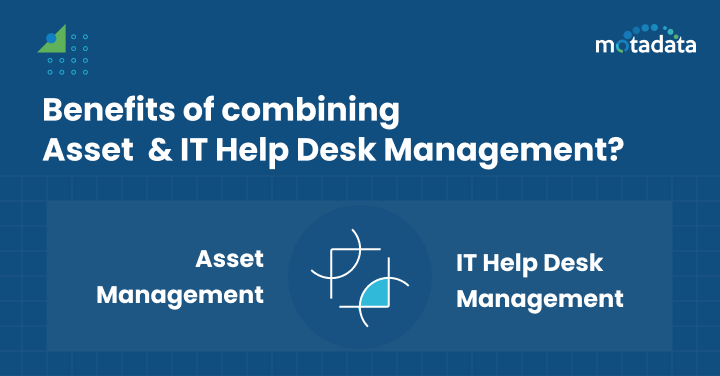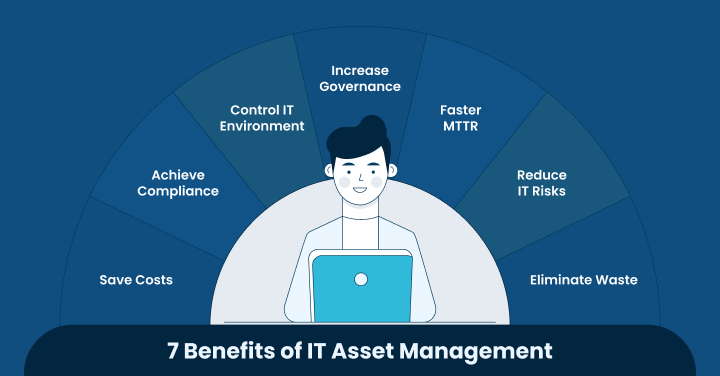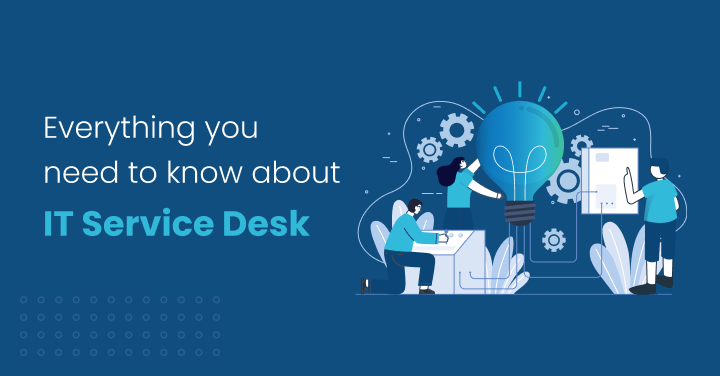Integrating IT Asset Management (ITAM) with your service desk is crucial for streamlining business activities and optimizing resource utilization.
The ITAM process encompasses the tracking, managing, and reporting hardware assets throughout their lifecycle, ensuring that data centers operate efficiently and cost-effectively.
By aligning ITAM with your service desk, you create a unified system that enhances visibility and control over assets from procurement to retirement.
This integration enables better decision-making, reduces downtime, and improves compliance with industry regulations.
Moreover, it fosters a proactive approach to asset management, helping businesses anticipate and mitigate potential issues before they escalate.
This blog will explore the key steps to seamlessly integrate ITAM with your service desk, ensuring your organization reaps the benefits of a well-coordinated and efficient IT infrastructure.
Steps to Integrate IT Asset Management (ITAM) With Your Service Desk
1. Assess Your Current ITAM and Service Desk Systems
Before your IT team integrates the ITAM system with the service desk, assess the inventory of the current ITAM and service desk tools.
Evaluate their current status, functionalities, features, drawbacks, or limitations.
Assess the efficacy of your current tools and technologies, existing asset tracking and management procedures, the size of your asset inventory, and other details.
By evaluating these requirements, your organization will be able to determine better the features that are essential for the integration process.
Identify gaps between both systems to determine which processes can become more efficient through integration.
For example, check if there are duplicate asset data or if you are missing the essential files for service desk tickets.
List all key areas where integration can enhance functionality and facilitate smoother data flow.
Also, consider how the integration impacts the overall user experience and its alignment with other IT service management processes.
2. Define Integration Goals and Objectives
After assessing ITAM and service desk systems, defining or setting your integration goals is essential.
In this step, you must write down the purpose behind integrating ITAM and service desk systems.
Some of the common goals are improved efficiency, enhanced compliance, streamlining incident and problem management processes, asset optimization, better data accuracy, and reduced human intervention.
These objectives must align with your company’s overall business and IT goals.
3. Choose the Right Tools and Technologies
Choosing the right tools and technologies is the next step and is highly crucial for successful integration.
In this step, you must evaluate different IT asset management software available in the market and look for features like APIs, ease of use, vendor support, and built-in integration options.
Also, make sure it is compatible with both systems and integrates seamlessly.
ServiceNow, BMC Remedy, and Ivanti, Motadata are some of the top platforms available in the market that offer smooth integration of both systems and support most of the shared features.
To maximize software licensing compliance, monitor software installations and usage, and handle software contracts and procurement, you should also consider software asset management solutions.
By selecting the appropriate tools and technology, you can guarantee that your integration process is productive, successful, and compliant with your company’s needs.
4. Plan the Integration Process
Creating a comprehensive plan is also essential for this integration process as it will help keep the process on track.
This step entails developing an implementation schedule, specifying a methodical procedure for combining the two systems, and milestones.
Determine the essential integration tasks, including data mapping, system configuration, and process alignment.
Make it clear who is in charge of each step of the integration process.
Roles and responsibilities assigned will help maintain responsibility and facilitate team coordination.
So, develop a plan including each step’s roles, tasks, responsibilities, and timelines.
By systematizing and structuring the integration process, you can reduce risks, expedite implementation, and ensure that it aligns with your organization’s overall IT goals.
5. Implement the Integration
Once you are ready with the integration plan, it is time to execute the set integration activities seamlessly.
Ensure the data mapping between the two systems is accurate and configuration settings are in place.
These settings will help synchronize the data and create a smooth workflow for different methods, including incident, change, and problem management.
Communicate and collaborate with your stakeholders and ensure they have the proper training and roles assigned for each step.
You can even start with a small pilot project to test the process.
This will help identify and fix problems before the significant rollout, offer insightful information, and aid in improving the integration strategy.
After the trial runs well, gradually expand integration to additional departments inside the company.
In addition to reducing disruption, a phased rollout enables small-scale modifications based on performance indicators and user feedback.
Ensure the integration is regularly updated and optimized to match your organization’s changing demands.
6. Train Staff and Update Processes
Another crucial step in integrating ITAM with your service desk is training and familiarizing your employees with the new workflow.
Under this step, you can run training sessions and give your staff a better understanding of the functionalities and reporting mechanisms.
Also, update them about the process and its impact on their daily tasks.
Change the present protocols to include the new integrated processes.
Record any new actions or modifications to guarantee uniformity and compliance with the updated procedures.
Further, identify improvement areas and deal with gaps or difficulties by routinely assessing the training’s efficacy and the revised procedures.
7. Monitor and Optimize Integration
Continuous monitoring and improvement are necessary to ensure the seamless integration of ITAM with your service desk.
This stage entails routinely assessing the integrated system’s performance and updating it as needed to maximize its efficacy and efficiency.
You can use performance metrics or KPIs to measure the performance and identify areas for improvement. These insights can further be used to implement corrective actions.
Collect user and stakeholder feedback regularly to refine and identify pain points in the integration process.
Introduce open communication and teamwork benefits to promote ongoing progress.
Review and update your integration goals and objectives regularly to ensure they align with the business goals.
Best Practices for Successful Integration
It’s crucial to adhere to industry best practices if you want your IT asset management process and service desk integration to go well.
Here are a few crucial recommended set of business practices to think about:
1. Ensure Data Accuracy and Consistency
Data accuracy is highly crucial for better optimization of assets and informed decision-making.
However, Data accuracy and consistency are the key challenges in this integration process.
To ensure you have accurate data each time, update and validate your asset data in the ITAM system regularly.
Verify the different attributes to ensure data accuracy.
Data consistency across various systems and activities must be maintained by establishing data governance procedures.
There are several data integration and data quality tools available in the market you can rely on to enhance data accuracy and consistency.
Further, care for any errors or contradictions in the data by routinely reviewing data quality reports.
2. Promote Collaboration Between Teams
Facilitating collaboration enables smooth communication, exchange of knowledge, and process alignment.
The ITAM and service desk teams should have frequent meetings and conversations to exchange ideas, problems, and best practices.
To break down organizational silos and advance cross-functional cooperation, make sure to cultivate a culture of collaboration and teamwork.
Assign each team specific roles and tasks and encourage open communication while exchanging information.
Ensure that each team knows exactly how their job fits into the more extensive IT asset management and service desk operations processes.
You can even implement collaborative tools and technology that promote knowledge sharing and communication.
These best practices will eventually improve the overall efficiency of ITAM systems.
3. Leverage Automation and AI
The IT asset management (ITAM) and service desk integration can be significantly improved by utilizing automation and artificial intelligence (AI).
AI and automation technologies can increase productivity, optimize workflows, and offer insightful information for better decision-making.
Consider implementing these practices to reduce human error and improve data accuracy using automation tools.
Further, your team can better identify patterns, trends, and anomalies using AI technologies.
These insights will help you make more informed decisions. By leveraging automation and AI, you can drive efficiency and effectiveness.
4. Focus on User Experience
Create the integration to improve end users’ and support desk agents’ experiences.
Streamline procedures and enhance usability by gathering feedback to understand user preferences.
An intuitive integration guarantees improved satisfaction and increased adoption rates.
Consider conducting user surveys to learn more about their pain points.
With these insights, make changes to enhance user experience. Further, provide comprehensive documentation and resources for support.
What are the benefits of combining Asset Management and IT Help Desk Management?
Organizations can reap various benefits by integrating IT help desk and asset management.
The following are the main benefits of combining these two roles:
1. Better Information
Integrating the two systems can provide more accurate information that can be further used for decision-making.
It provides a detailed view of your information technology assets and updates on license information and maintenance records.
These insights can eventually be used in asset allocation, resource capacity planning, and budget decision-making.
This information also enables users to identify the risky areas and areas for improvement in IT management.
For instance, it’s simple to spot out-of-date software versions that could be dangerous for your data security and to take preventative action against them.
Your decision-making processes will be more consistent, less prone to error, and more efficient overall if you integrate these two systems and guarantee that you have a single source of truth for all your IT asset data.
2. Centralized Visibility
Another benefit of this integration process is centralized visibility, i.e., you can track and manage all IT assets from a single source.
It can be attained from a single platform, be it asset location, usage, or any other detail that may help improve the overall user experience.
You can also clearly understand your asset inventory with consolidated visibility, including the assets’ overall quantity, lifecycles, and expenditures.
This data is essential for efficient budgeting and asset planning. Additionally, it makes regulatory obligations easier to comply with and protects you from the fines and penalties that come with non-compliance.
3. Automated Tasks
By automating certain operations, integrating IT Asset Management (ITAM) with your service desk helps increase productivity and efficiency.
Routine and repetitive tasks can be automated to save time and IT resources for more strategic endeavors.
For example, new assets can also be automatically assigned to the right user as they are introduced to the system.
Automation lowers the possibility of human error while simultaneously saving time.
Your asset management operations can be made less prone to errors and inconsistencies by doing away with repetitive tasks and manual data entry.
4. Enhanced Productivity
You may save manual labor, boost operational effectiveness, and raise overall productivity by simplifying and automating IT asset management procedures.
Further, the necessity for duplicate record-keeping and manual data entry can be removed.
All parties involved will have access to correct and current information because of the integration’s ability to synchronize and update data in real time between the two systems.
All these actions will gradually help enhance productivity and improve customer service.
5. Better Customer Experience
Integrating IT Asset Management (ITAM) with your service desk can enhance the overall customer experience by facilitating the quicker and more effective handling of IT issues and requests.
Your service desk team can offer end customers greater help and faster resolutions if they have a complete picture of IT assets and the data associated with them.
Upon receiving a user’s support request or complaint, the service desk has instant access to pertinent data regarding the user’s hardware and software, such as maintenance records, license details, and warranty information.
As a result, issues may be resolved more quickly, and customers will be more satisfied with the service desk team’s accurate and tailored support.
Tips to make ITAM and ITSM work ‘Better Together’
To improve the collaboration between IT Asset Management (ITAM) and IT Service Management (ITSM), companies should take into account the following tips:
Carefully break the operation silos - Encourage the ITAM and service desk teams to work together and share information. Sharing information and discussing minor details with team members can help identify and resolve issues faster. Thus, eliminating silos guarantees that both groups collaborate to achieve shared objectives.
Begin small, then aim for big— To acquire buy-in and demonstrate benefit, start small with integration projects or pilot projects. This will help you test and analyze areas for improvement. As you integrate new systems and processes, you can progressively increase the scope of your activities in the future.
Use ITAM to fill the management gaps - Utilize ITAM skills to fill the gaps in service delivery and asset management. Ascertain that ITSM procedures benefit from ITAM data and vice versa. This will further help IT asset managers enhance productivity and add more value to their business in the long run.
ITSM processes integration helps ensure ITAM data accuracy - The accuracy and consistency of asset data are guaranteed by integrating ITAM and ITSM procedures, which enhances overall IT asset management.
FAQs
Better strategic decision-making, enhanced regulatory compliance, and expedited asset management procedures are advantages of integrating IT Asset Management (ITAM) with your service desk. In terms of managing IT assets, it enables consolidated visibility, improved information, and increased efficiency.
Explore integration solutions and IT asset management (ITAM) software like ServiceNow, BMC Remedy, and Ivanti to seamlessly connect ITAM with service desks.
These tools offer features such as automated asset tracking, software usage analysis, licensing management, and procurement system connectivity.
Choose software that aligns with your company’s needs and provides reliable technical support to ensure smooth integration. With the help of these tools, you can achieve desired results and improve overall efficiency and effectiveness.
Integrating the IT asset management system with the service desk ensures accurate tracking of software licenses, maintenance records, and IT assets, enhancing compliance and risk management. It enables businesses to reduce non-compliance risk, proactively monitor adherence to regulatory standards, and prevent fines related to license violations or out-of-date software versions.
Several crucial phases are involved in successfully integrating IT Asset Management solutions with the service desk. Right from establishing data synchronization protocols to choosing suitable technologies for integration, defining integration goals, outlining ITAM and service desk procedures, and carrying out frequent audits to guarantee data accuracy and process effectiveness are some of these tasks.
Success depends on adhering to industry best practices and including ITAM and service desk stakeholders at every stage of the integration process.








